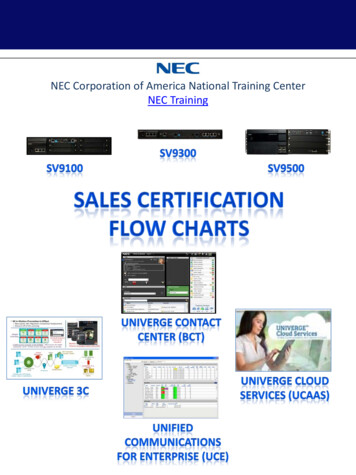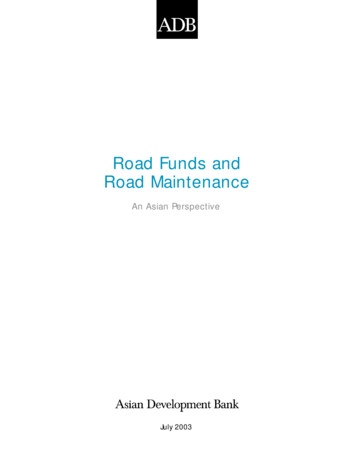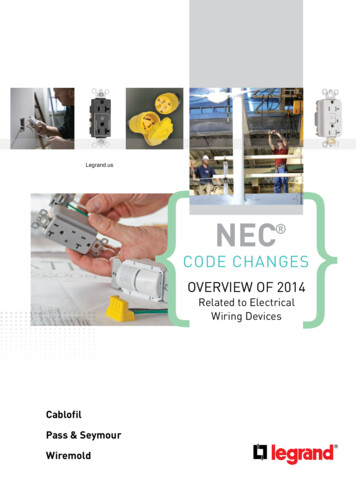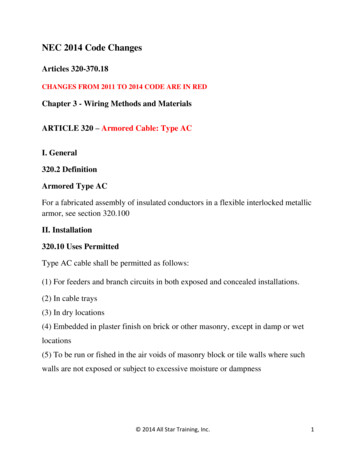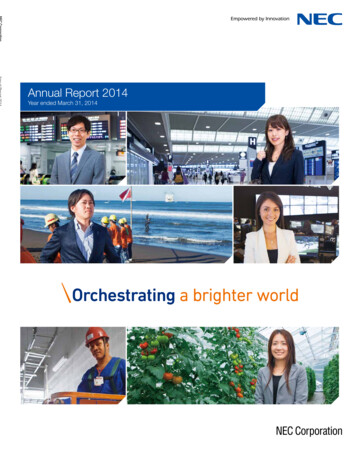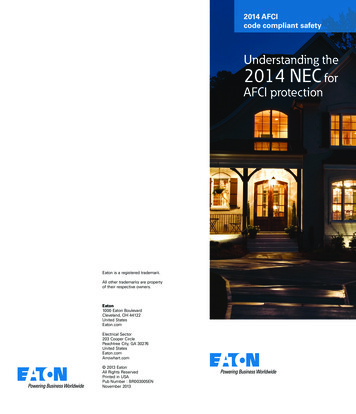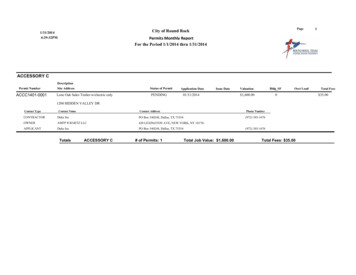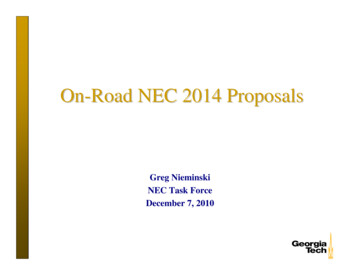
Transcription
On-Road NEC 2014 ProposalsGreg NieminskiNEC Task ForceDecember 7, 2010
2011 NEC Change Proposal Results 11 Proposals Submitted 5 Proposals Accepted 625.2 – Added Electric Motorcycles625.2 – Changed charging to power transfer forConnector625.2 – Changed charging to power transfer forInlet625.2 – Changed EVSE to transferring energybetween the premise wiring and the EV625.2 – Added Rechargeable Energy StorageSystem
2014 NEC Change Proposals625.13 Electric Vehicle Supply Equipment Clarify when cord-and-plug connection ispermitted Define Fixed EVSE (Equipment fastened in place)similar to 250.110Fixed EVSE could meet requirements of 625.18,19, and 29 with either cord-and-plug or hardwiring.
2014 NEC Change ProposalsPEV Load Diversity Demand Factors Develop demand factors for multiple EVSElocations to account for load diversity.Will require actual data to supportrecommendations. Automated Load Control Add new clause on automated load control formultiple EVSE locations.
2014 NEC Change ProposalsVehicle to Grid Issues Male Plug Blades Energized Review 702 and 705 to see if changes are neededto 625.26. Establish Neutral Add isolation transformer requirement to establishneutral for vehicle to house when islanded fromgrid.
2014 NEC Change ProposalsDC Input to EVSE Add option for EVSE to be powered fromDC source Eliminate extra conversion stage for premiseswith Photovoltaic System / Battery Storage
2014 NEC Change Proposals625.25 Personnel Protection System Add option to allow 1.5 meters betweenPPS and plug PPS would have to be rated for drive overCurrent requirement of 12 inches causes PPS tohang down which can result in damagedreceptacles.
2014 NEC Change Proposals625.29 (D) 4 Supply Circuits Clarify outlet labeling requirements forventilation Shouldn’t be 625.15 (C) “Ventilation Required”
2014 NEC Change ProposalsTables 625.29 (D1) and (D2) Combined Tables 625.29 (D1) and (D2)into a single table with both m3/min andcfm data
2014 NEC Change ProposalsPEV Load Information Add clause on PEV loads in Article 625and reference in Table 220.3OR Add 220.14 (M) on PEV loads Consider adding to PEV loads toexamples in Annex D
2014 NEC Change Proposals625.17 Cable Investigate removing EVSE cablerequirements from 625 as they arecovered in end product standard (UL)
IEC Project Stages and Timetable for Standards Development.Project StageAssociated DocumentNameAbbreviationMinimum Timeline(for commentand/or voting)Proposal stageNew Work Item Proposal NP3 months for votingPreparatory stageWorking draftWD12 monthsrecommendedCommittee stageCommittee draftCD2‐4 months forcommentEnquiry stageEnquiry draftIEC/CDV5 months forcomment andvotingApproval stageFinal Draft InternationalStandardFDIS2 months for votingPublication stageInternational StandardIEC or ISO/IEC1.5 months1
IEC – High Voltage Shore Power EquipmentInternational Electrotechnical Commission (IEC) Technical Committee No.18IEC TC18 MT26 ‐ IEC/ISO/IEEE 60092‐510 Electrical installations in ships ‐Special Features ‐ High Voltage Shore Connection Systems (HVSC‐Systems)Last meeting November 2010 – Berlin, GermanyBrian Sisco to report.2
60092‐510 StatusAfter final editing of the draft CDV by the three (3) joint committeeconvenors in December, document will be forwarded to the IEC for reviewand circulation as a CDV for 5 months. If no negative votes are received thedocument will be circulated as a FDIS for two months followed by apublished standard with a target date of the 3rd or 4th quarter of 2011The combined committee of experts are from: IEC Project Team PT 60092‐510: High Voltage Shore Connection Systems(HVSC Systems) International Organization for Standardization (ISO) TechnicalCommittee ISO/TC 8, Ships and Marine Technology, Subcommittee SC 3,Piping and Machinery, Working group WG11: Cold Ironing IEEE, PCIC Marine Industry Subcommittee, P1713 Electrical Shore‐to‐Ship Connections WG3
International Electrotechnical Commission (IEC) Sub‐Committee SC23HIEC 62613, Plugs, Socket‐Outlets, Ship Connectors And Ship Inlets For High‐Voltage Shore Connection Systems, (HVSC‐Systems)IEC 62613 has been divided into two parts:4
Part 1: General requirements. Contains constructional and testrequirements for both 7.2kV and 12 kV plugs, socket‐outlets(receptacles), connectors and ship inlets. Special requirements weredeveloped to include:– non‐rewireable accessory ‐ accessory so constructed that the cableor wiring cannot be separated from the accessory without making itpermanently useless– field‐rewireable accessory ‐ accessory so constructed that it can berewired by skilled personnel as qualified by the manufacturer– non‐field‐rewireable accessory ‐accessory so constructed that it shallonly be rewired by the manufacturer’s authorized personnel5
Preliminary CDVs were completed in August but are still waiting for finalengineering drawings from the manufacturers before the CDVs can beissued for comment and vote.Pending a positive vote to both the CDV and following FDIS, the Standard isexpected to be published late in 2011.6
National EV Permitting Project UpdateNational RenewableEnergy LaboratoryCarl Rivkin, P.E.Date December 7, 2010NREL is a national laboratory of the U.S. Department of Energy, Office of Energy Efficiency and Renewable Energy, operated by the Alliance for Sustainable Energy, LLC.
The EV Charging Station Project Background Started with a request to the Vehicle Technologies program manager from the GridInteraction Technical Team (GITT) GITT requested that the DOE assist in developing streamlined permittingprocedures The request was quite extensive and included data base development to assistjurisdictions as well as outreach to distribute information on EVs and EV charging The permit template portion of the request was funded The permit template is a set of requirements that would likely apply in mostjurisdictions and could be used as the basis for a generic permit Would apply to residential charging installations and would potentially eliminate theneed for an inspection prior to operationNational Renewable Energy LaboratoryInnovation for Our Energy Future
Draft Permit ContentsPermit is divided into 4Sections:1.Jurisdiction info2.Code requirements3.Certification statement4.ChecklistNational Renewable Energy LaboratoryInnovation for Our Energy Future
Permit TemplateNational Renewable Energy LaboratoryInnovation for Our Energy Future
Permit TemplateNational Renewable Energy LaboratoryInnovation for Our Energy Future
Permit TemplateNational Renewable Energy LaboratoryInnovation for Our Energy Future
EV Permitting Project UpdateDraft Permit template complete in FY10Feedback from multiple jurisdictions indicates that they see value in the permit template butare waiting to see the rate of permit applications submitted before taking actionIn October NREL published a Request for Information (RIF) soliciting interested parties to workwith NREL in implementing a streamlined permitting process for EV charging stationsSeveral jurisdictions and organizations responded including the following: Bay Area Air Quality Management District (BAAQMD)Monterrey Bay Electric Vehicle AllianceUtah Department of Environmental QualityMecklenburg, NC Building Code DepartmentBay Area Climate CollaborativeDuke EnergyNREL met with these interested parties and reviewed the permit templateThey expressed an interest in NREL developing information that would put the permittemplate into context by providing information on EV charging and associated safetyissuesNREL will work to develop this information and work these or other jurisdictions can tostreamline their EV charging station permitting processNational Renewable Energy LaboratoryInnovation for Our Energy Future
DatabaseAs project has progressed more interest in potential database component has been expressed by interested parties,such a Boulder County, COData base would coordinate the activities of at least thefollowing entities: Car dealer EV charging station installer Jurisdiction issuing permit for EV charging station Utility supplying charging stationNational Renewable Energy LaboratoryInnovation for Our Energy Future
Contextual InformationSeveral jurisdictions and organizations expressed aninterest in providing information to put the permit templatein contextThis information would include:– Explanations of what a PHEV is and how it is charged– Basic safety information on vehicles and chargingThe DOE AFDC web site contains information that may beusefulNational Renewable Energy LaboratoryInnovation for Our Energy Future
EV Permitting Project Update/AFDC web SiteNational Renewable Energy LaboratoryInnovation for Our Energy Future
EV Permitting Project Update/AFDC Web SiteNational Renewable Energy LaboratoryInnovation for Our Energy Future
EV Permitting Project Update/AFDC Web siteNational Renewable Energy LaboratoryInnovation for Our Energy Future
EV Permitting Project Update/AFDC Web SiteNational Renewable Energy LaboratoryInnovation for Our Energy Future
EV Permitting Project Update/AFDC Web SiteNational Renewable Energy LaboratoryInnovation for Our Energy Future
ConclusionThere is interest in using permit templateThere is also interest in producing information that puts thepermit template in a larger contextThere is interest in a coordinating data baseNREL has as their FY11 task implementing the permittemplate or some other change that would streamline theEV charging station permitting process in three jurisdictionsNational Renewable Energy LaboratoryInnovation for Our Energy Future
December 7, 2010Tim RoseIEC 62196-3 Convenor
March, 2010 a new work proposal waspresented by Japan for DC Charging Plugs, Socket-Outlets, and Vehicle Couplers Operating Voltages up to 1,000 V DC Rated Currents up to 400A DC Proposal was affirmed by vote in June, 2010 First Project Team/Working Group meetingheld September 28-29, 2010 in Osaka, JapanDecember 7, 2010 IWC - Tempe, AZ2
Working Draft proposed by Japan and commentssubmitted by the National Committees were reviewed Proposals from China, USA and Germany were alsopresented and discussed Consensus was reached to consider these threeadditional proposal as well as any other proposalsubmitted by January 14, 2011 Relevant documents that are also being considered areIEC 62196-1, 61851-1 and 61851-23December 7, 2010 IWC - Tempe, AZ3
USA ProposalGermany ProposalJapan ProposalChina ProposalAC / DC Universal Type 1AC / DC Universal Type 2DC Type 1DC Type 2Corresponding to IEC62196-2, Type 1Corresponding to IEC62196-2, Type 2
January 14, 2011National Committee Proposals dueJanuary 31, 2011Circulation of WP for commentsFebruary 28, 2011NC comments on WD dueApril 6-7, 2011PT 62196-3 Meeting in USAJune, 20113-month period for commentsOctober, 2011PT 62196-3 MeetingJanuary, 20125-month period for voting andcommentsJune, 2012PT 62196-3 MeetingFDISAugust, 20122-month period for votingISDecember, 2012Publication of ISWorking DraftCDCDVDecember 7, 2010 IWC - Tempe, AZ5
How Sustainable Planning Can Enable The SuccessfulDeployment of Electric Vehicle NetworksJames Aloisi1
2
The 21st Century will, out ofnecessity, introducefundamental, transformativechanges to vehicular travel3
Challenge #1Current TransportationSystems Cannot ScaleTo A World of 9 BillionPeople4
Challenge #2Traffic Congestionand Air PollutionIncreasingly ThreatenEconomic Growthand Prosperity ByDiminishing Qualityof Life
Challenge #3EnergyDependenceThreatensNational Securityand Prosperity6
Electric Vehicles Can Help SolveThe Growing Mobility, Clean Airand Energy Security Challenges7
!Edison’s great invention: the practicalincandescent bulb.Edison’s great insight: building a power plantso people had the electricity needed to usethe bulb.(With apologies to George Westinghouse )
‐ Or ‐Chaos Is Multiplicity Without RhythmM.C. Escher10
“Those Who Cannot Remember The Past AreCondemned To Repeat It.” George Santayana
Sustainable Planning:Leveraging Electric Vehicles to SparkEconomic Growth and Prosperity“Sustainable Planning Is AnInvestmentin the Future.”World Bank Report, Eco2Cities
Planning Along A Time Line– Promotion Period – next 1 to 2 years– Near Term – next 5 years– Long Term – next 10 -15 years– Full Development – when the EVinfrastructure is fully in place, whatdoes the EV Network look like?14
Three Principles To GuideEV Planning:Access, Connectivity &Integration15
1. Establishing Access to EV Charginginfrastructure through deployment of anample, equitable and strategic EV ChargingNetwork.2. Connecting EVs and the EV Charging Networkinto Smart Grid and Smarter Mobility Networks.3. Integrating the EV Charging Network into acoherent transportation management plan andenergy infrastructure plan, designed to enhancemobility, improve air quality and establish amore sustainable energy supply system.
Charging Access Must Be Ample,Equitable and Strategic Ample means an EV Charging Infrastructure thatsatisfies demand and eases range anxiety. Equitable means that EV Charging Infrastructure isreasonably available (by location and cost) to anycitizen who wishes to own an electric vehicle. Strategic means deploying an EV Network toencourage economic growth through improvedmobility and co‐ordinated land use.
London’s Approach To AccessIn the UK, less than 40% of urban householdshave off‐street parking availability.The London EV Network aims to ensure thatno Londoner is more than one mile from apublic charging point by 2015.Any Londoner wishing to buy an EV shouldhave reasonable access to charging facilities.
Planning Helps Identify HouseholdsWith Off‐Street Parking
Planning Helps Identify WherePotential Adopters of EVs Live.
Planning Enables Strategic Approaches ToLocating EV Charging Stations
In Contrast
2014 NEC Change Proposals 625.13 Electric Vehicle Supply Equipment Clarify when cord-and-plug connection is permitted Define Fixed EVSE (Equipment fastened in place) similar to 250.110 Fixed EVSE could meet requirements of 625.18, 19, and 29 with either cord-and-plug or hard wiring. 2014 NEC Change Proposals PEV Load Diversity Demand Factors Develop demand factors for multiple EVSE
